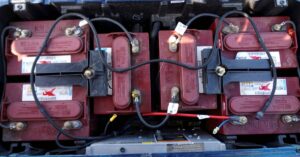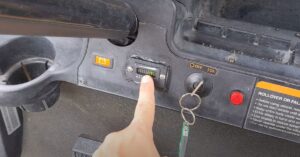What Happens If Golf Cart Batteries Run Out Of Water? [Detailed Overview]
If you use a golf cart, whether for golfing or getting around your property, it’s important to know about the batteries. Golf cart batteries, particularly the lead-acid type, need enough water to work well.
But what happens if they run out of water? If golf cart batteries run out of water, it can lead to reduced battery performance and potential damage. Water helps maintain electrolyte levels and keeps the battery cool during operation.
The mystery surrounding this issue is surprisingly prevalent, and in this blog post, we’ll dive right into it, uncovering the truths behind golf cart batteries and the water they need.
Why Does Your Golf Cart Battery Need Water?
![What Happens If Golf Cart Batteries Run Out Of Water? [Detailed Overview] 1 image 11](http://giftedgolfers.com/wp-content/uploads/2023/06/image-11.png)
Water is an essential component for the proper functioning of golf cart batteries, especially those of the lead-acid type.
It serves a vital role in facilitating the electrochemical reactions that occur within the battery, allowing it to store and release electricity efficiently.
Here are the key reasons why your golf cart battery needs water:
Electrochemical Reaction
Water actively participates in the electrochemical reaction that takes place inside a lead-acid battery.
This reaction involves the interaction between the lead plates and sulfuric acid, resulting in the production of lead sulfate, water, and energy.
The presence of water is crucial as it enables this reaction to occur smoothly, ensuring optimal electricity generation.
Maintaining Performance
Adequate water levels in the battery are essential for maintaining its performance.
When the water level drops below the required threshold, the electrochemical reaction is hindered, leading to a reduction in the battery’s electricity generation.
As a result, your golf cart may experience diminished performance or may fail to operate altogether.
Preventing Sulfation
The lead plates within the battery should always remain submerged in a mixture of water and sulfuric acid, known as the electrolyte.
If the water level decreases and the plates are exposed to air, a process called sulfation occurs.
Sulfation leads to the formation of hardened lead sulfate crystals on the plates, which cannot be converted back during the charging process.
This hinders the battery’s ability to charge and discharge effectively, negatively impacting its overall performance and longevity.
Preventing Overheating and Damage
Insufficient water levels in the battery can cause overheating during the charging process.
Overheating can lead to swelling or cracking of the battery casing, potentially resulting in leaks and, in severe cases, complete battery failure.
Maintaining adequate water levels helps dissipate heat and prevents the battery from reaching dangerously high temperatures, ensuring its safe operation.
What Happens If Golf Cart Batteries Run Out Of Water?
![What Happens If Golf Cart Batteries Run Out Of Water? [Detailed Overview] 2 image 12](http://giftedgolfers.com/wp-content/uploads/2023/06/image-12.png)
Water plays a fundamental role in the operation of golf cart batteries, particularly those of the lead-acid variety.
The water isn’t just a dormant resident inside the battery casing; it’s an active participant in the electrochemical reactions that enable the battery to store and release electricity.
When the water level in these batteries depletes, a series of unfavorable events occur, affecting the performance and longevity of the battery and, by extension, the golf cart.
Impaired Electrochemical Reaction
The primary role of water in a lead-acid battery is to facilitate an electrochemical reaction.
This reaction involves lead plates and sulfuric acid, producing lead sulfate, water, and energy.
When the water level falls, this reaction can’t proceed as intended, leading to reduced electricity generation.
As a result, your golf cart may experience diminished performance or may not function at all.
Exposure and Sulfation of the Lead Plates
The lead plates inside the battery should always remain submerged in the electrolyte – a mixture of water and sulfuric acid. If the water level drops below the plates, they get exposed to air.
This exposure leads to a process known as sulfation, where the lead sulfate crystals harden on the plates and aren’t converted back during the charging process.
Sulfation hinders the battery’s ability to charge and discharge, significantly impacting its performance.
Overheating and Potential Damage
Without adequate water, the battery can overheat during charging, leading to potential damage.
Overheating may cause the battery casing to swell or crack, leading to leaks. In severe cases, it could lead to battery failure.
Reduced Battery Life
The constant cycle of discharging and recharging a battery causes a gradual loss of water.
If not regularly replenished, the resulting problems (like sulfation and overheating) can drastically shorten the lifespan of the battery.
If left unaddressed, it may lead to a point where the battery cannot hold a charge at all.
What To Do When Golf Cart Battery Run Out Of Water?
![What Happens If Golf Cart Batteries Run Out Of Water? [Detailed Overview] 3 image 13](http://giftedgolfers.com/wp-content/uploads/2023/06/image-13-1024x609.png)
When a golf cart battery runs out of water, it is important to take appropriate action to prevent any damage and ensure the battery’s optimal performance. Here’s what you can do:
Safety first
Before proceeding, ensure you are wearing appropriate personal protective equipment, such as gloves and safety glasses.
Check the battery water levels
Most golf cart batteries have removable caps on top. Carefully remove the caps to expose the battery cells.
Inspect water levels
Look into each cell and check the water level. Ideally, the water should cover the lead plates inside the battery, but it should not exceed the maximum fill line indicated on the battery case. If the plates are exposed, it means the water level is too low.
Add distilled water
If the water level is low, use distilled water to fill each cell. Distilled water is free from impurities that could potentially harm the battery.
Slowly pour water into each cell until the water level reaches the appropriate mark or covers the plates. Be cautious not to overfill.
Allow the water to settle
After adding water, give the battery some time to allow the water to settle. This typically takes a few minutes.
Reinstall the caps
Once the water has settled, carefully reinstall the caps on each cell. Make sure they are securely tightened but not excessively tightened.
Charge the battery
After replenishing the water, it is crucial to recharge the battery fully. Use an appropriate charger for your golf cart battery and follow the manufacturer’s instructions. It is generally recommended to charge the battery until it reaches a full charge.
Regular maintenance
To avoid future water-related issues, establish a regular maintenance routine for your golf cart battery.
Check the water levels regularly and top up with distilled water as needed. Additionally, follow the manufacturer’s recommendations regarding battery maintenance and storage.
FAQs
Let’s delve into the most frequently asked questions regarding golf cart batteries and their water requirements!
Can I use any type of water to refill my golf cart batteries?
No, it’s best to use distilled water as it doesn’t contain minerals or impurities that could damage your battery.
How often should I check the water level in my golf cart batteries?
Generally, you should check the water levels every month. However, during hot weather or heavy usage periods, you might need to check more often.
Can I overfill the battery with water?
Yes, overfilling can cause the acid-water mixture to overflow, which could damage the battery and the surrounding areas.
What are the signs that my battery water level is low?
Signs of low water levels include decreased performance, the battery getting unusually hot, or swelling of the battery case.
What precautions should I take when filling water in my golf cart batteries?
Always wear protective gear like gloves and goggles when filling water, and make sure the golf cart is switched off.
Conclusion
In conclusion, the water in your golf cart batteries is not just there to fill space – it’s a vital part of the functioning and longevity of your golf cart.
Ignoring water levels can lead to significant damage and the potential need for costly replacements.
As with many things, prevention is always better than cure, so remember to keep an eye on those water levels and treat your golf cart batteries with the care they deserve.






